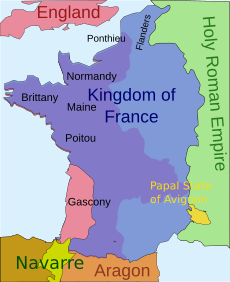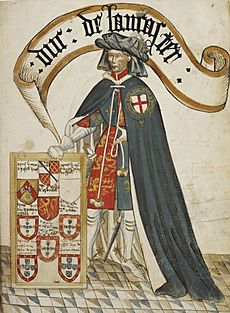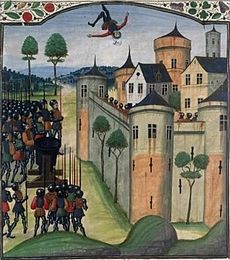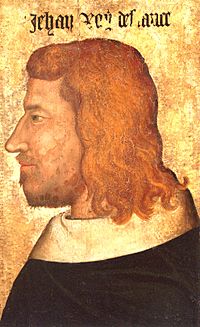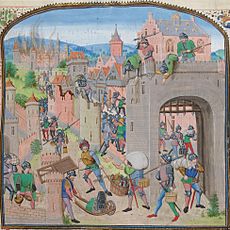Gascon campaign of 1345 facts for kids
Quick facts for kids Gascon campaign of 1345 |
|||||||||
|---|---|---|---|---|---|---|---|---|---|
| Part of the Edwardian Phase of the Hundred Years' War | |||||||||
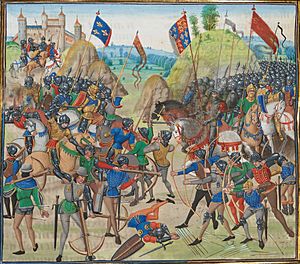 A battle between French and English armies, as imagined by a contemporary chronicler |
|||||||||
|
|||||||||
| Belligerents | |||||||||
| Commanders and leaders | |||||||||
| Strength | |||||||||
| Under 8,000 at any time | Up to 20,000 | ||||||||
| Casualties and losses | |||||||||
| Light | Very heavy | ||||||||
The Gascon campaign of 1345 was a major part of the Hundred Years' War. It took place in Gascony, a region in south-west France controlled by England. Henry, Earl of Derby, led the English and Gascon forces.
This campaign, from August to November 1345, was the first time England had a big success on land during the war. Derby's army won two important battles against larger French armies. They captured many French nobles and knights. These prisoners were later freed for a large sum of money, called a ransom. This made Derby and his soldiers very rich.
After these victories, the English gained more power and respect in the area. They got more taxes and new soldiers. The French, on the other hand, found it much harder to get money and troops from the region.
Before Derby arrived, Ralph, Earl of Stafford, had already started by attacking two French castles. When Derby got there, he quickly gathered his troops. He marched straight to Bergerac, where a large French army was gathering. He won a big victory there.
Then, Derby tried to capture Périgueux, a major city. But the French sent a huge army led by John, Duke of Normandy. Derby had to pull back. Later, a French army besieged an English castle at Auberoche. Derby returned with a small force and launched a surprise attack. He won another huge victory.
After this, the French army began to fall apart. Soldiers were not paid or fed, and many left. The Duke of Normandy gave up and disbanded his army. Derby then captured more French towns and castles, including the strong town of La Réole. He stayed there for the winter. Even after Derby's main army went home, smaller English and Gascon groups kept fighting. They captured many more important places.
Contents
Why the War Started
Since 1066, English kings had owned lands in France. This meant they were like tenants, or vassals, to the French kings. This situation often caused arguments between the two countries. French kings always tried to take back these lands. By 1337, England only held Gascony in the southwest and Ponthieu in the north.
The people of Gascony liked being ruled by the distant English king. He mostly left them alone. They did not want a French king who would interfere in their lives. In 1337, King Philip VI of France said that King Edward III of England had broken his duties as a vassal. So, Philip declared that Gascony would be taken back by France. This event started the Hundred Years' War, which lasted for 116 years.
Gascony's Importance
Gascony was very important to England. Each year, over 1,000 ships left Gascony. They carried more than 80,000 tuns of local wine. A tun was a large barrel holding 252 gallons (954 liters). The taxes England collected on wine from Bordeaux, the capital of Gascony, were huge. They brought in more money than all other taxes combined.
Bordeaux was a rich city because of this trade. It had over 50,000 people, more than London at the time. By 1337, French attacks had made English Gascony much smaller. It had to import food, mostly from England. If ships stopped coming, Gascony would starve and England would lose a lot of money. The French knew this.
Edward III could not send many soldiers to Gascony at first. So, the Gascons had to defend themselves. In 1339, the French even attacked Bordeaux itself. Usually, Gascony could raise 3,000 to 6,000 soldiers. Most of these were foot soldiers. But two-thirds of them were needed to guard castles.
There was no clear border between English and French lands. Many nobles owned land in both areas. They might be loyal to different kings for different parts of their land. Small estates had tower houses, and larger ones had castles. Fortified towns grew up near bridges and river crossings. Armies could find food by moving often. But to besiege a castle, they needed supplies by water.
Warfare was mostly about taking castles and getting local nobles to switch sides. Many lords would support whichever country was stronger. By 1345, English territory was mostly a strip along the coast. The French had strong castles deep inside what used to be English Gascony. Some of these castles, like Libourne and Blaye, threatened Bordeaux.
The Campaign Begins
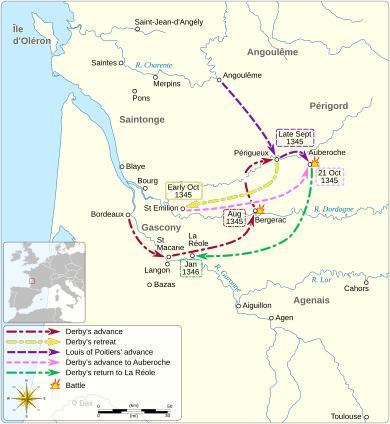
Red arrows – Derby's advance to Bergerac and Périgueux
Orange arrow – Derby's withdrawal
Blue arrows – Louis of Poitiers' advance to Périgueux and Auberoche
Pink arrow – Derby's return to Auberoche
Green arrow – Derby's move back to Gascony and La Réole}}
In early 1345, King Edward III planned to attack France in three places. One small force would go to Brittany. A slightly larger force, led by Henry, Earl of Derby, would go to Gascony. The main English army would go with Edward to northern France.
Ralph, Earl of Stafford, went to Gascony first in February. Derby was made the King's commander in Gascony in March. He was given permission to raise 2,000 soldiers in England and more in Gascony. Derby had a lot of freedom to make his own decisions. His orders were to "do the best you can" if there was war.
The French knew about England's plans. But they did not have enough money to raise armies for all three places. They thought the main English attack would be in northern France. So, they sent most of their money and soldiers there. South-west France was told to defend itself.
Derby Arrives
Derby's army left England in late May. Bad weather delayed them, but they finally arrived in Bordeaux on August 9, 1345. His force included 500 knights and 1,500 English and Welsh archers. Some archers rode ponies to move faster. Many of his soldiers were experienced fighters.
The Gascons, who had been waiting for Derby, had already started fighting. They captured two castles on the Dordogne River in June. This broke the peace agreement. Stafford had also started besieging the French towns of Blaye and Langon. These sieges could be easily supplied by ship. The French called for more soldiers.
Small groups of Gascons also raided French areas. Some local French nobles even joined them. This kept most of the weak French garrisons busy and made them ask for help. Many areas were left undefended.
Edward's main army sailed in June but was scattered by a storm. They had to return to England. This meant Edward's main attack could not happen that year. King Philip of France then sent more soldiers to Brittany and Gascony.
Battles of Bergerac and Auberoche
On August 9, Derby arrived in Bordeaux. After two weeks of getting more soldiers, he joined Stafford's forces. Stafford had been careful, but Derby had a different plan. He wanted to attack the French quickly before they could gather all their forces. The French army in the region was led by Bertrand de l'Isle-Jourdain. He decided to gather his forces at Bergerac, a key town with an important bridge over the Dordogne River.
Derby decided to attack Bergerac. Taking the town would give the English a strong base. It would also cut off French forces north and south of the river. The French did not expect an attack, as the English had been fighting defensively for eight years.
Derby moved fast and surprised the French army at Bergerac on August 26. He won a decisive victory. Many French soldiers were killed or captured. Among the prisoners were ten important noblemen. Derby's share of the ransoms and loot was huge, about £34,000. This was four times his yearly income from his lands. Bergerac fell to the English a few days later and was looted. This victory gave the English a key base and showed local lords that England was strong again.
Derby rested his army for two weeks. He left soldiers in Bergerac and moved north with 6,000 to 8,000 men. He took several strongholds on his way to Périgueux, the capital of Périgord. Périgueux's defenses were old, but a large French force defended it. Derby blocked the city and captured strongholds around it.
John, Duke of Normandy, King Philip VI's son, took command of the French army. He had over 20,000 soldiers. In early October, a large part of his army relieved Périgueux. Derby's force had to retreat towards Bordeaux. The French then started besieging English-held castles. A French force of 7,000 men, led by Louis of Poitiers, besieged Auberoche castle.
A messenger from Auberoche reached Derby. Derby returned with a small force of 1,200 English and Gascon soldiers. After a night march, Derby attacked the French camp on October 21 while they were eating dinner. He surprised them and caused heavy losses. The French fought back, but the small English force in the castle attacked them from behind. The French broke and ran.
French losses were very high. Many French nobles were captured, including the second-in-command, Bertrand de l'Isle-Jourdain, two counts, seven viscounts, and many knights. Louis of Poitiers, the French commander, died from his wounds. The ransoms from these prisoners made a fortune for Derby and his soldiers. Derby alone made at least £50,000.
English Gains
The Duke of Normandy was very upset by the defeat at Auberoche. He reportedly gave up his command and went back to Paris. The French stopped all their sieges of English castles. Reports said the French army was falling apart. Soldiers were not paid or fed, horses lacked food, and many soldiers left. They even sold their equipment.
Even though the French army was much larger, the Duke of Normandy retreated to Angoulême and disbanded his army. This might have been because the French ran out of money. Derby was left almost unopposed for five months.
Derby moved south as winter approached. He began clearing French castles from the border. He captured the small castle at Pellegrue and stormed Monségur. Then he moved to the large, strong town of La Réole. This town was important because it was on the Garonne River, only 35 miles (56 km) from Bordeaux. La Réole had been English before the French captured it 21 years earlier. The town had lost its special trading rights under French rule.
On November 8, the citizens of La Réole helped the English. They distracted the French soldiers and opened a gate for Derby's army. The French soldiers fled to the citadel, a very strong fortress. The English began to dig tunnels under it. The French agreed to surrender if they were not rescued within five weeks. They sent a message to the Duke of Normandy, but he had just disbanded his army. In early January 1346, the French soldiers left, and the English took over. The town got its old rights back. Derby spent the rest of the winter there.
After the main armies went home for winter, small groups of English and Gascon soldiers kept fighting. They cleared the Garonne valley of French forces. They also raided French towns and castles that were not well defended. Langon, which Stafford had failed to take, was captured. Derby often made deals with towns. He offered them trading rights if they opened their gates to the English. This helped towns avoid a siege. Many towns chose to surrender to Derby. Some even forced French soldiers to leave. A letter from French commanders in November said towns were joining the English "daily." The French defenders were losing hope.
The Duke of Bourbon, the new French commander in Gascony, was surprised by the attacks. Stafford attacked Aiguillon, a very important town, in late November. The people of Aiguillon attacked the French soldiers and opened the gates to the English. By March 1346, almost all of the Agenais region was in English hands. Bourbon held only the capital, Agen, and four castles. All of these were surrounded by the English.
What Happened Next
The 1345 campaign was a disaster for the French. It was even worse because they did not expect it. For eight years, the English and Gascons had not launched any big attacks. The French lost many towns and castles. They also had many soldiers killed and many nobles captured. These captured nobles could not fight until they paid their large ransoms. Much of this money went to help the English war effort.
Towns across southwest France quickly started to repair and improve their defenses. They also made sure they had enough soldiers. It became very hard for the French to collect taxes or get men to join the army.
After two and a half years of uneasy peace, the war had started again with French defeats. In the border region, the English gained a lot of confidence and respect. This brought in more taxes and new soldiers for the English armies. Many Gascon nobles who were unsure about which side to support now chose the English.
Derby's success helped secure Gascony for England. It also prepared the way for future English attacks. He led another successful campaign in 1346. Historians praise Derby's leadership in this campaign. They call him a "superb tactician" and "brilliant." One writer from 50 years later called him "one of the best warriors in the world."
In October 1345, the Earl of Northampton's campaign in northern Brittany failed. So, the French decided to focus their main effort in 1346 on Gascony. A very large French army, much bigger than Derby's, gathered early in the year. It was led by the Duke of Normandy. Their plan was to retake La Réole, but first, they had to recapture Aiguillon. Stafford, with 900 English and Gascon soldiers, defended Aiguillon for eight months. Derby kept his main force at La Réole, threatening the French. This made it hard for the French to get supplies.
Meanwhile, King Edward III was gathering a large army in England. The French thought it would go to Gascony to help Aiguillon. But instead, it landed in Normandy in July. This surprised the French and started the Crécy campaign. King Philip VI ordered his son, the Duke of Normandy, to leave the siege of Aiguillon and march north. John did so, but he arrived two weeks after Philip's army had been badly defeated at the Battle of Crécy.
The areas facing Derby were left almost undefended. He sent local Gascon forces to besiege the few remaining French strongholds. Derby then led about 2,000 soldiers on a great mounted raid, called a chevauchée. For two months, this raid was very successful. Not only Gascony, but much of the Duchy of Aquitaine, was now firmly in English hands. This land was held by England until France officially gave it up in 1360 in the Treaty of Brétigny.
Images for kids


